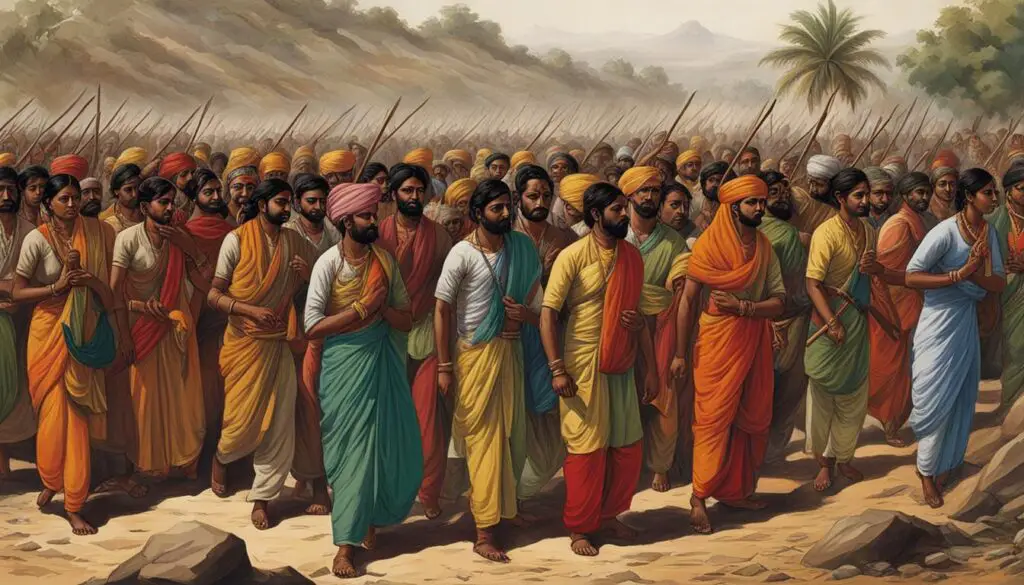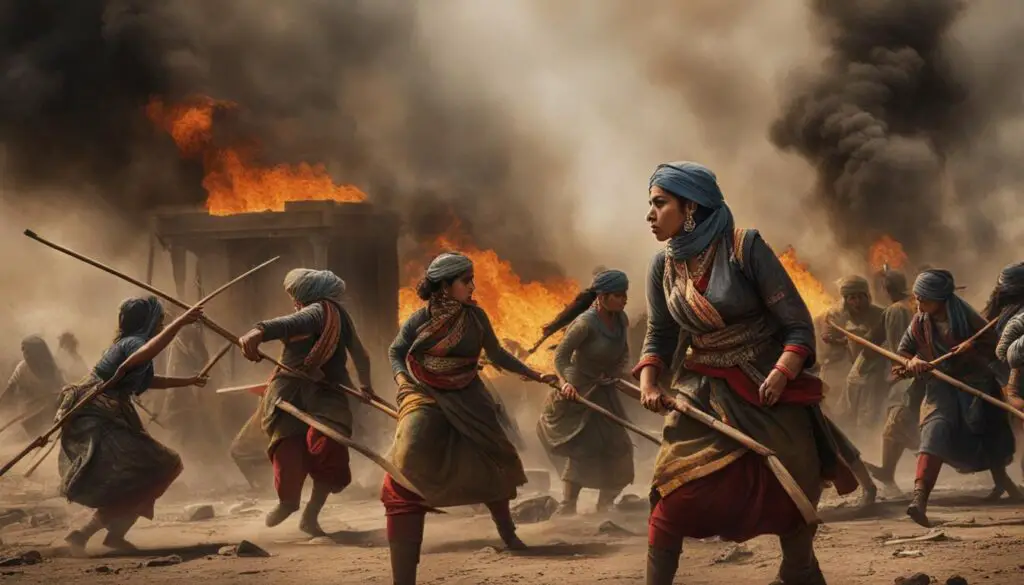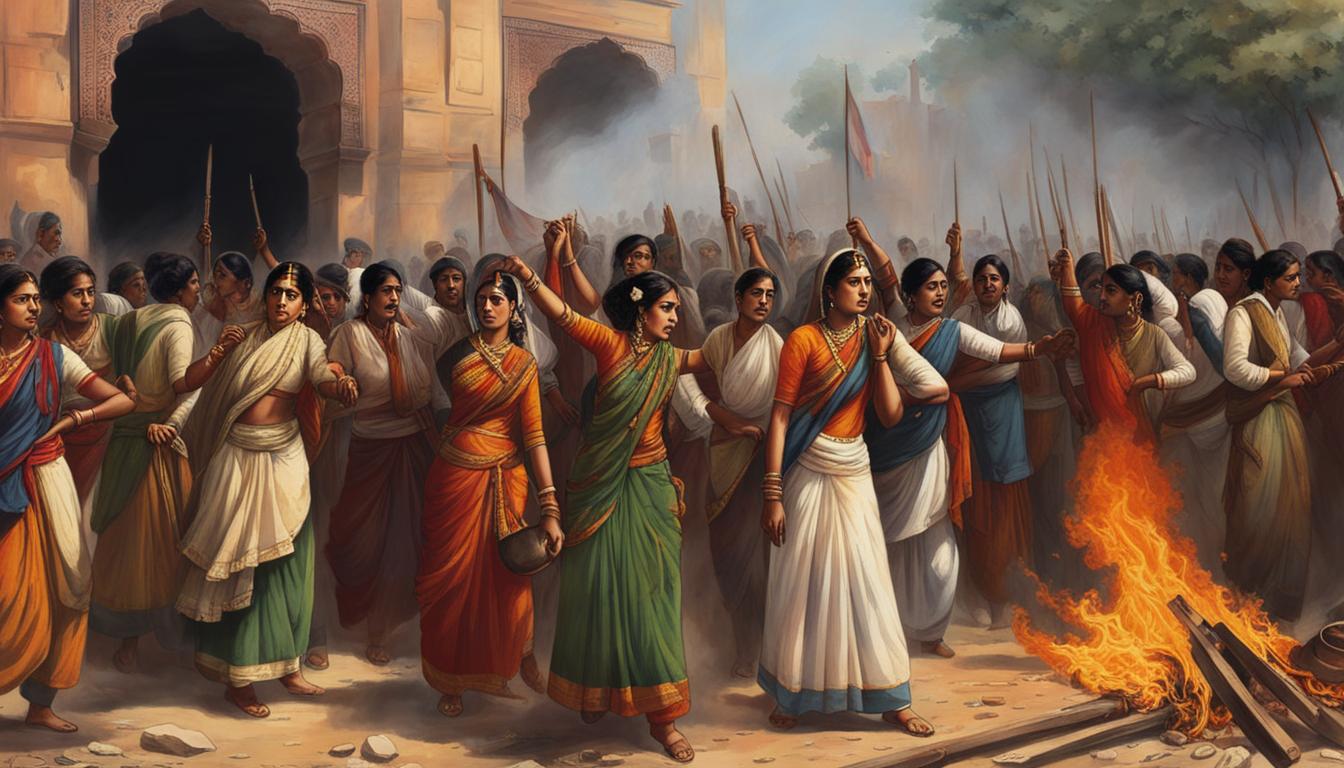Welcome to our article on the Channar Revolt, a remarkable uprising that took place in 19th-century India. This movement, also known as the Channar Lahala or Maru Marakkal Samaram, was a powerful response to the oppressive social norms of the time, championing the cause of social equality. Led by the Nadar climber women, this revolt challenged the caste system and fought for the right to wear upper-body clothes covering their breasts.
The Channar Revolt had a profound impact on society and sparked a movement that sought to break free from the chains of social hierarchy. Join us as we explore the causes and consequences of this significant uprising, shedding light on its historical significance and the lessons it holds for us today.
Key Takeaways:
- The Channar Revolt was an uprising that occurred in 19th-century India, led by the Nadar climber women.
- It aimed to challenge the oppressive social norms of the time and advocate for social equality.
- The revolt had a lasting impact, ultimately leading to the recognition of the right of Nadar women to cover their breasts.
- The Channar Revolt highlighted the power dynamics and social inequalities of the time, paving the way for social change.
- It serves as an inspiration for future generations and a testament to the resilience of individuals fighting for their rights.
Background of the Channar Revolt
The Channar Revolt of the 19th century in Kerala was deeply influenced by the prevailing caste system and the social status of different communities. Lower-caste women, particularly the Nadar climbers, faced the oppressive practice of baring their chests as a sign of respect to individuals of higher status. This practice also extended to Nair women, who were not allowed to cover their breasts in front of Brahmin men.
During this period, the Hindu society underwent various reforms and transformations. One significant development was the freedom granted to Nair women to dress as they pleased, through a Royal Proclamation in 1865. However, the Nadar community, burdened by their low social status and the discrimination they faced, sought an alternative path.
In search of equal treatment and social recognition, many Nadar women embraced Christianity. This newfound faith played a pivotal role in their fight for equality. They began wearing long cloths as a symbol of their commitment to their religious beliefs and as an assertion of their right to be treated with respect and dignity.

This image illustrates the deep-rooted caste system and untouchability prevalent in society, which formed the backdrop for the Channar Revolt.
Through their adoption of Christianity and their choice of clothing, the Nadar women challenged the social hierarchy imposed upon them and demanded equal treatment. This dissatisfaction with the existing system culminated in the historic Channar Revolt.
The Course of the Channar Revolt
The Channar Revolt was a momentous movement that underwent various phases and witnessed significant events that shaped its course. The struggle was sparked by the oppressive social norms of the time, particularly the requirement for lower-caste women, including the Nadar women, to expose their breasts as a sign of respect to individuals of higher status.
In 1813, Colonel John Munro, the British dewan in the Travancore court, granted permission for Nadar women who converted to Christianity to wear upper cloth. However, this order was later withdrawn due to objections from members of the Raja’s council, who feared it would undermine the existing caste system.
Undeterred, Nadar women continued their fight for the right to dress like higher-caste women. In their pursuit of equality, they engaged in protests and civil disobedience, leading to violent clashes and the burning of schools and churches.
The Travancore queen issued a proclamation in 1829, denying Nadar women the right to wear upper cloth, further intensifying the revolt. This period witnessed escalating violence and conflicts between the Travancore government and the Nadar community.
Finally, in 1859, the Travancore Palace was compelled to issue a decree that allowed Nadar women to cover their breasts with jackets or coarse cloth, although the style differed from that worn by higher-class Nair women. This decree marked a significant victory for the Nadar community and their long-standing struggle for recognition.
The Channar Revolt revealed the power dynamics and social inequalities of the time, highlighting the oppressive norms that women from lower castes had to endure. It stands as a testament to the resilience and determination of the Nadar women, who fought for their right to dress without discrimination.

“The Channar Revolt represented a fight for social justice and equality. It showcased the courage and strength of the Nadar women, who were determined to challenge oppressive norms and demand their right to dress like women from higher castes.”
Conclusion
The Channar Revolt holds a significant place in the history of Kerala and India as a powerful movement against social hierarchy and gender oppression. Initiated by Nadar women, this uprising challenged the oppressive norms that restricted their freedom of dress. The revolt not only brought attention to the prevalent inequalities in society but also paved the way for social change.
While the Channar Revolt centered around the right of Nadar women to cover their breasts, its significance extends far beyond that. It symbolizes a broader fight for equality and recognition in a society marked by social hierarchies. The historical significance of this momentous revolt cannot be undermined, as it shed light on the need to challenge oppressive practices and strive for gender equality.
Today, the Channar Revolt serves as a reminder of the importance of standing up against oppressive systems. It inspires future generations to question societal norms and fight for their rights, regardless of their gender or social standing. The lessons learned from the Channar Revolt are a testament to the resilience and determination of those who dare to challenge the status quo in pursuit of equality.
FAQ
What was the Channar Revolt?
The Channar Revolt, also known as the Channar Lahala or Maru Marakkal Samaram, was a significant uprising that occurred between 1813 and 1859 in the Travancore kingdom of India. It was led by the Nadar climber women, who fought for the right to wear upper-body clothes covering their breasts.
What were the causes of the Channar Revolt?
The Channar Revolt was deeply rooted in the caste system prevalent in Kerala during the 19th century. Lower-caste women, such as the Nadar climbers, were subjected to the practice of baring their chests as a sign of respect to individuals of higher status. This practice extended to Nair women as well, who were also not allowed to cover their breasts in front of Brahmin men.
How did the Channar Revolt unfold?
The Channar Revolt had several phases and witnessed significant events that shaped its course. In 1813, Colonel John Munro, the British dewan in the Travancore court, granted permission for women who converted to Christianity to wear upper cloth. Dissatisfied with these restrictions, Nadar women continued their fight for the right to dress like higher-caste women, leading to violent clashes and the burning of schools and churches. The violence escalated in the later years, ultimately pressuring the Travancore Palace to issue a decree in 1859 that allowed Nadar women to cover their breasts with jackets or coarse cloth, although they were still different from the style worn by higher-class Nair women.
What was the impact of the Channar Revolt?
The Channar Revolt holds a significant place in the history of Kerala and India, representing a powerful struggle against social hierarchy and gender oppression. It was a movement initiated by Nadar women to challenge the oppressive norms that restricted their freedom of dress. The revolt brought attention to the inequalities prevalent in society and paved the way for social change. Today, it stands as a reminder of the importance of challenging oppressive practices and the ongoing effort to achieve gender equality.
